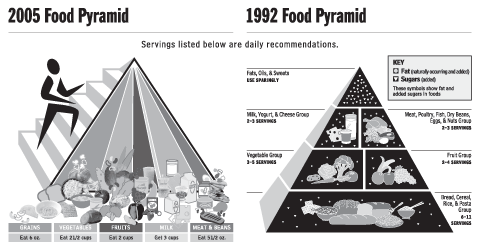Government Releases New Food Pyramid

The Department of Agriculture has introduced a new food pyramid-pyramids to be precise. Instead of a one-size fits all pyramid, there are now 12 different versions, each slightly different, depending on a person's age, sex, and level of physical activity. The new nutritional guideline system is called MyPyramid.
âMyPyramid is about the ability of Americans to personalize their approach when choosing a healthier lifestyle that balances nutrition and exercise,â said Agriculture Secretary Mike Johanns.
The food pyramid is similar to the old one in shape only. The new version is color-coded: orange for grains, green for vegetables, red for fruits, yellow for fats and oils, blue for milk, and purple for meats and beans. It also features a stick person climbing staircase to symbolize the importance of exercising every day.
 |
In general, the pyramid recommends that each day people eat about 6 ounces of grains, 2.5 cups of vegetables, 2 cups of fruit, 3 cups of milk, 5.5 ounces of meat or beans, and only a small amount of fats and oils.
The new food pyramid has its critics, however. Dr. Walter Willett of the Harvard School of Public Health said, âI don't think the graphic itself is much of an advance at all except that it shows physical activity.â
Rethinking the Food Pyramid: The New Guidelines
In 1992, the Department of Health and Human Services and the Department of Agriculture created the food pyramid. It recommended the number of servings of each food group a person should eat daily to stay healthy. The food groups in the pyramid include: grains, vegetables, fruits, dairy, meat, and fats and oils. Today, more than two-thirds of Americans are overweight or obese. In 2005, the government, recognizing a potential health crisis, issued new, tougher guidelines on how to get-and stay-healthy and fit. Here are the highlights:
Whatâs In
FRUITS AND VEGETABLES: Five servings of fruits and vegetables a day-the old recommendation-are no longer enough to maintain good nutrition and prevent disease. The new goal is nine servings a day: four half-cup servings of fruit per day and five of vegetables or legumes, such as beans, peas and lentils.
WHOLE GRAINS: Look for whole kernels of wheat or other grains in your bread and cereals. Whole-grain goods are packed with more nutrients than white bagels, bread, cakes or muffins made from refined flours.
EXERCISE: Get up and get moving! The new guidelines say people should exercise for at least 30 minutes most days of the week.
What to Avoid
SODIUM: For the first time, the government recommends a target for salt intake: no more than 1 teaspoon of salt a day. Too much salt can cause high blood pressure.
FATS: Fat should make up 35% or less of your daily calorie intake. Try to avoid eating trans fats (found in processed foods). These types of fat are often listed as âpartially hydrogenatedâ oils in the list of ingredients.
SUGAR: Itâs hard to remove sugar from your diet, but you can certainly cut down the amount you eat. Soda is loaded with sugar. The guidelines suggest that in addition to cutting back on sweet sodas, people should opt for low-fat milk, water, or any other beverage thatâs low in sugar.
